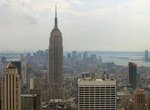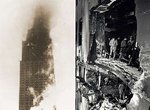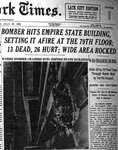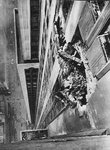Thorlifter
Captain
Aerospaceweb.org | Ask Us - B-25 Empire State Building Collision
One of the many who contributed to the war effort was Lt. Col. Bill Smith, a decorated pilot who had flown a B-17 Flying Fortress for the US Army Air Force. Now returned from Europe, Smith was put in charge of a routine flight to ferry a B-25D Mitchell bomber from Bedford, Massachusetts, to Newark, New Jersey. The bomber, operating under the call sign Army 0577, was nicknamed "Old John Feather Merchant" and had been converted into a VIP transport. Smith was to pick up his commanding officer at Newark before continuing on to Sioux Falls Army Air Base in South Dakota. The B-25 was a medium twin-engine bomber, far smaller than the B-17 Smith flew over Europe, but both designs saw widespread use throughout the War. Accompanying Smith on his journey was SSgt. Christopher Domitrovich and an aviation machinist's mate from the Navy named Albert Perna. Perna had hitched a ride on the flight to return to Brooklyn and console his parents following the death of their other son who lost his life in the Pacific.
The B-25 departed on its fateful mission just before 9 AM headed south for New Jersey. Less than an hour into the flight, however, Smith received warnings from the New York Municipal Airport in Queens (now called LaGuardia Airport) that thick fog had enveloped the city. The field's control tower ominously reported, "We're unable to see the top of the Empire State. Suggest you land here." Though Smith acknowledged the message, he apparently ignored it and requested clearance to continue to Newark.
The plane was only minutes from LaGuardia but lost in a dense fog that limited visibility. Flight rules of the time required aircraft to maintain an altitude of at least 2,000 ft (610 m) over the city, but Smith dropped to less than half that height hoping to regain sight of the ground. That he surely did, but the pilot had misjudged his location and soon found his plane bounding through the concrete canyons of the city's skyscrapers. The bomber soon attracted attention from alarmed citizens as its roaring engines echoed off the facades of buildings below. Those working in the upper stories of office buildings raced to windows to watch in amazement as a plane flew beneath them, turning and banking rapidly as its wingtips barely missed some structures. One observer was Army Air Force Lt. Frank Covey who spotted the doomed B-25 from his room in the Biltmore Hotel. Covey watched in disbelief as the plane barely missed the New York Central Office Building and was no higher than its 22nd floor.
The bomber raced west roughly following 42nd Street before turning south near the intersection with 5th Avenue. This turn proved a fatal mistake as it brought the lumbering plane directly towards the north face of the world's tallest building. Stan Lomax, a local sports announcer for radio station WOR, was driving to work when he first noticed the sound of propeller engines of the approaching B-25. As he looked up, he yelled, "Climb, you fool, climb!" from his car window.
At the last moment, Lt. Col. Smith must have seen the profile of the Empire State Building looming out of the fog. He tried to pull up while banking away, but the distance was too short and the bomber's velocity too great. At approximately 9:49 AM, the B-25 plunged into the 78th and 79th floors of the skyscraper some 975 ft (295 m) above ground level. The plane impacted at an estimated speed of 200 miles per hour (320 km/h) making the building shake under the force of the collision. The high-speed crash also caused the plane's fuel tanks to explode, sending a fireball 100 ft (30 m) high and releasing blazing gasoline down the facade of the building. Sheets of flame also raced through the maze of hallways and stairwells inside the building, reaching at least as far down as the 75th floor.
The crash tore a hole about 18 ft (5.5 m) wide by 20 ft (6 m) tall in the 34th Street exterior of the Empire State Building. While the 78th and 79th floors bore the brunt of the damage, one of the B-25's engines fell down an elevator shaft and set off a major fire in the basement. The other engine hurtled across the building and tore through seven walls before emerging from the 33rd Street side of the tower. The debris crashed through the roof of a thirteen-story building across the street where another fire erupted. Other heavy wreckage, including the landing gear, also caused damage to the Empire State and nearby buildings while Stan Lomax reportedly saw part of a wing catapulting towards Madison Avenue.
Crowds soon gathered near the base of the wounded skyscraper. According to Walter Daniels of the New York Times, "People sensed disaster. Everyone started running towards Fifth Avenue." The raging fire burned away the fog treating the assembled masses to a clear view of the spectacle above. As flaming fuel and wreckage showered down, however, spectators fled the area to find cover under nearby buildings. Taxi driver Raphael Gomez brought his vehicle to a screeching halt as debris rained down on his cab. "I was so scared, I just sat there. People were running all over," he stated.
After the 1941 attack on Pearl Harbor and long years of world conflict, many naturally thought the city was under attack. This confusion is exemplified by one of the building's workers Doris Pope. "That day, as we were getting ready to take our coffee break, we heard this terrible noise, and the building started to shake. ... As we looked out our third-floor window, we saw debris fall on to the street. We immediately thought New York was being bombed."
Another witness to the disaster was Donald Maloney, a 17-year-old apprentice pharmacist's mate in the US Coast Guard. Maloney had been shopping nearby when he saw the crash and darted into a drug store. "Give me morphine, hypos, needles, first aid kits! It's an emergency," he demanded. Maloney then raced into the Empire State Building to render aid to victims of the crash.
The need for help was greatest on the 79th floor where the offices of the National Catholic Welfare Conference were located. On this Saturday morning, about 20 people were present. Most were young female clerks organizing aid for refugees of the war. Six of the girls never had a chance as they were engulfed in flame and died instantly at their desks, and more workers succumbed to the flames as they tried to escape. Another victim was a female publicist thrown through a window by the blast. Paul Dearing, who was working in the far corner of the Catholic offices, was also killed after he leapt from a window and struck a ledge a few stories down. The rest of the aid workers miraculously reached the safety of a fireproof stairwell required of high-rise buildings.
Catherine O'Connor, who was working near the crash site, further describes the horror of the disaster: "The plane exploded within the building. There were five or six seconds--I was tottering on my feet trying to keep my balance--and three-quarters of the office was instantaneously consumed in this sheet of flame. One man was standing inside the flame. I could see him. It was a co-worker, Joe Fountain. His whole body was on fire. I kept calling to him, 'Come on, Joe; come on, Joe.'" Though Fountain managed to walk out of the fire and escaped the building, his injuries were too severe and he died a few days later. Another victim was a janitor who was trapped by fire and lost his life on the 78th floor. Luckily, this floor was only used for mechanical spaces and storage. Had it been occupied, the death toll could have been considerably higher.
Yet for each tragic death, dozens more defied the odds and escaped the conflagration. A group of 60 men, women, and children were visiting the observation deck on the 86th floor when they were hurled across the building by the B-25 impact. Thick smoke from the intense inferno quickly filled the floor making breathing difficult. Guides were unable to find keys to the glass doors onto the open balcony outside but soon broke them open to let in fresh air. The group was then led down 86 flights of the fireproof stairwell to safety.
As the group passed the 80th floor, they heard pounding on the walls and screams of those trapped inside. This floor held the offices of Daniel Nordan and his assistant Arthur Palmer. Nordan later recalled, "We were lifted three feet out of our chairs and thrown to the floor--I thought it was a Japanese bomb!" The pair tried to flee into a corridor but they were driven back by intense flames from the crash just one floor down. They also discovered a female elevator operator who was badly burned and panicking. The group was only able to escape after the two men used a hammer to break through a wall to another office leading to an undamaged hallway and the fireproof staircase. The pair carried the injured girl through the passage and down the stairs to rescue workers.
One of the many who contributed to the war effort was Lt. Col. Bill Smith, a decorated pilot who had flown a B-17 Flying Fortress for the US Army Air Force. Now returned from Europe, Smith was put in charge of a routine flight to ferry a B-25D Mitchell bomber from Bedford, Massachusetts, to Newark, New Jersey. The bomber, operating under the call sign Army 0577, was nicknamed "Old John Feather Merchant" and had been converted into a VIP transport. Smith was to pick up his commanding officer at Newark before continuing on to Sioux Falls Army Air Base in South Dakota. The B-25 was a medium twin-engine bomber, far smaller than the B-17 Smith flew over Europe, but both designs saw widespread use throughout the War. Accompanying Smith on his journey was SSgt. Christopher Domitrovich and an aviation machinist's mate from the Navy named Albert Perna. Perna had hitched a ride on the flight to return to Brooklyn and console his parents following the death of their other son who lost his life in the Pacific.
The B-25 departed on its fateful mission just before 9 AM headed south for New Jersey. Less than an hour into the flight, however, Smith received warnings from the New York Municipal Airport in Queens (now called LaGuardia Airport) that thick fog had enveloped the city. The field's control tower ominously reported, "We're unable to see the top of the Empire State. Suggest you land here." Though Smith acknowledged the message, he apparently ignored it and requested clearance to continue to Newark.
The plane was only minutes from LaGuardia but lost in a dense fog that limited visibility. Flight rules of the time required aircraft to maintain an altitude of at least 2,000 ft (610 m) over the city, but Smith dropped to less than half that height hoping to regain sight of the ground. That he surely did, but the pilot had misjudged his location and soon found his plane bounding through the concrete canyons of the city's skyscrapers. The bomber soon attracted attention from alarmed citizens as its roaring engines echoed off the facades of buildings below. Those working in the upper stories of office buildings raced to windows to watch in amazement as a plane flew beneath them, turning and banking rapidly as its wingtips barely missed some structures. One observer was Army Air Force Lt. Frank Covey who spotted the doomed B-25 from his room in the Biltmore Hotel. Covey watched in disbelief as the plane barely missed the New York Central Office Building and was no higher than its 22nd floor.
The bomber raced west roughly following 42nd Street before turning south near the intersection with 5th Avenue. This turn proved a fatal mistake as it brought the lumbering plane directly towards the north face of the world's tallest building. Stan Lomax, a local sports announcer for radio station WOR, was driving to work when he first noticed the sound of propeller engines of the approaching B-25. As he looked up, he yelled, "Climb, you fool, climb!" from his car window.
At the last moment, Lt. Col. Smith must have seen the profile of the Empire State Building looming out of the fog. He tried to pull up while banking away, but the distance was too short and the bomber's velocity too great. At approximately 9:49 AM, the B-25 plunged into the 78th and 79th floors of the skyscraper some 975 ft (295 m) above ground level. The plane impacted at an estimated speed of 200 miles per hour (320 km/h) making the building shake under the force of the collision. The high-speed crash also caused the plane's fuel tanks to explode, sending a fireball 100 ft (30 m) high and releasing blazing gasoline down the facade of the building. Sheets of flame also raced through the maze of hallways and stairwells inside the building, reaching at least as far down as the 75th floor.
The crash tore a hole about 18 ft (5.5 m) wide by 20 ft (6 m) tall in the 34th Street exterior of the Empire State Building. While the 78th and 79th floors bore the brunt of the damage, one of the B-25's engines fell down an elevator shaft and set off a major fire in the basement. The other engine hurtled across the building and tore through seven walls before emerging from the 33rd Street side of the tower. The debris crashed through the roof of a thirteen-story building across the street where another fire erupted. Other heavy wreckage, including the landing gear, also caused damage to the Empire State and nearby buildings while Stan Lomax reportedly saw part of a wing catapulting towards Madison Avenue.
Crowds soon gathered near the base of the wounded skyscraper. According to Walter Daniels of the New York Times, "People sensed disaster. Everyone started running towards Fifth Avenue." The raging fire burned away the fog treating the assembled masses to a clear view of the spectacle above. As flaming fuel and wreckage showered down, however, spectators fled the area to find cover under nearby buildings. Taxi driver Raphael Gomez brought his vehicle to a screeching halt as debris rained down on his cab. "I was so scared, I just sat there. People were running all over," he stated.
After the 1941 attack on Pearl Harbor and long years of world conflict, many naturally thought the city was under attack. This confusion is exemplified by one of the building's workers Doris Pope. "That day, as we were getting ready to take our coffee break, we heard this terrible noise, and the building started to shake. ... As we looked out our third-floor window, we saw debris fall on to the street. We immediately thought New York was being bombed."
Another witness to the disaster was Donald Maloney, a 17-year-old apprentice pharmacist's mate in the US Coast Guard. Maloney had been shopping nearby when he saw the crash and darted into a drug store. "Give me morphine, hypos, needles, first aid kits! It's an emergency," he demanded. Maloney then raced into the Empire State Building to render aid to victims of the crash.
The need for help was greatest on the 79th floor where the offices of the National Catholic Welfare Conference were located. On this Saturday morning, about 20 people were present. Most were young female clerks organizing aid for refugees of the war. Six of the girls never had a chance as they were engulfed in flame and died instantly at their desks, and more workers succumbed to the flames as they tried to escape. Another victim was a female publicist thrown through a window by the blast. Paul Dearing, who was working in the far corner of the Catholic offices, was also killed after he leapt from a window and struck a ledge a few stories down. The rest of the aid workers miraculously reached the safety of a fireproof stairwell required of high-rise buildings.
Catherine O'Connor, who was working near the crash site, further describes the horror of the disaster: "The plane exploded within the building. There were five or six seconds--I was tottering on my feet trying to keep my balance--and three-quarters of the office was instantaneously consumed in this sheet of flame. One man was standing inside the flame. I could see him. It was a co-worker, Joe Fountain. His whole body was on fire. I kept calling to him, 'Come on, Joe; come on, Joe.'" Though Fountain managed to walk out of the fire and escaped the building, his injuries were too severe and he died a few days later. Another victim was a janitor who was trapped by fire and lost his life on the 78th floor. Luckily, this floor was only used for mechanical spaces and storage. Had it been occupied, the death toll could have been considerably higher.
Yet for each tragic death, dozens more defied the odds and escaped the conflagration. A group of 60 men, women, and children were visiting the observation deck on the 86th floor when they were hurled across the building by the B-25 impact. Thick smoke from the intense inferno quickly filled the floor making breathing difficult. Guides were unable to find keys to the glass doors onto the open balcony outside but soon broke them open to let in fresh air. The group was then led down 86 flights of the fireproof stairwell to safety.
As the group passed the 80th floor, they heard pounding on the walls and screams of those trapped inside. This floor held the offices of Daniel Nordan and his assistant Arthur Palmer. Nordan later recalled, "We were lifted three feet out of our chairs and thrown to the floor--I thought it was a Japanese bomb!" The pair tried to flee into a corridor but they were driven back by intense flames from the crash just one floor down. They also discovered a female elevator operator who was badly burned and panicking. The group was only able to escape after the two men used a hammer to break through a wall to another office leading to an undamaged hallway and the fireproof staircase. The pair carried the injured girl through the passage and down the stairs to rescue workers.





